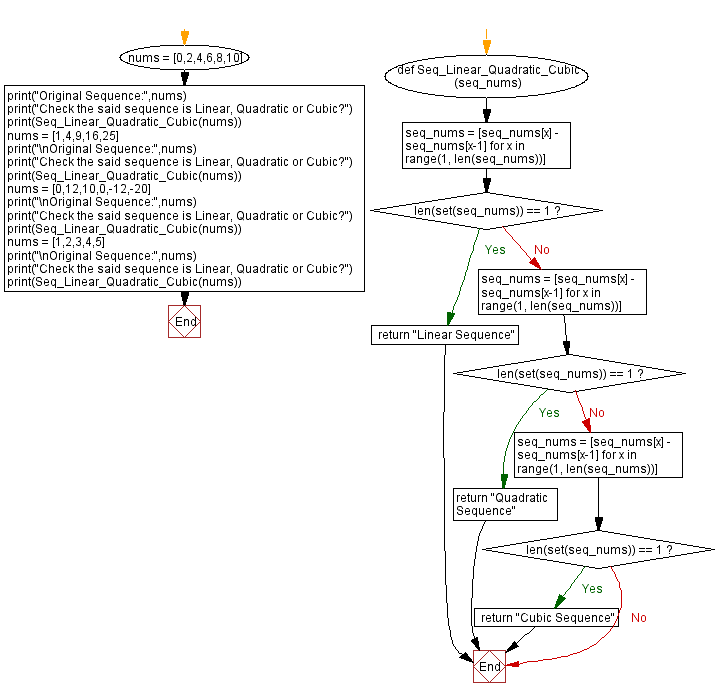Python: Check whether a given sequence is linear, quadratic or cubic
Sequence Type Identifier
Write a Python program to check whether a given sequence is linear, quadratic or cubic.
Sequences are sets of numbers that are connected in some way.
Linear sequence:
A number pattern which increases or decreases by the same amount each time is called a linear sequence. The amount it increases or decreases by is known as the common difference.
Quadratic sequence:
In quadratic sequence, the difference between each term increases, or decreases, at a constant rate.
Cubic sequence:
Sequences where the 3rd difference are known as cubic sequence.
Sample Solution:
Python Code:
# Define a function named Seq_Linear_Quadratic_Cubic that takes a sequence of numbers (seq_nums) as an argument.
def Seq_Linear_Quadratic_Cubic(seq_nums):
# Calculate the first-order differences between consecutive elements in the sequence.
seq_nums = [seq_nums[x] - seq_nums[x-1] for x in range(1, len(seq_nums))]
# Check if all differences are the same, indicating a linear sequence.
if len(set(seq_nums)) == 1:
return "Linear Sequence"
# Calculate the second-order differences between consecutive elements in the modified sequence.
seq_nums = [seq_nums[x] - seq_nums[x-1] for x in range(1, len(seq_nums))]
# Check if all differences are the same, indicating a quadratic sequence.
if len(set(seq_nums)) == 1:
return "Quadratic Sequence"
# Calculate the third-order differences between consecutive elements in the modified sequence.
seq_nums = [seq_nums[x] - seq_nums[x-1] for x in range(1, len(seq_nums))]
# Check if all differences are the same, indicating a cubic sequence.
if len(set(seq_nums)) == 1:
return "Cubic Sequence"
# Test the function with different sequences and print the results.
# Test case 1
nums = [0,2,4,6,8,10]
print("Original Sequence:", nums)
print("Check the said sequence is Linear, Quadratic, or Cubic?")
print(Seq_Linear_Quadratic_Cubic(nums))
# Test case 2
nums = [1,4,9,16,25]
print("\nOriginal Sequence:", nums)
print("Check the said sequence is Linear, Quadratic, or Cubic?")
print(Seq_Linear_Quadratic_Cubic(nums))
# Test case 3
nums = [0,12,10,0,-12,-20]
print("\nOriginal Sequence:", nums)
print("Check the said sequence is Linear, Quadratic, or Cubic?")
print(Seq_Linear_Quadratic_Cubic(nums))
# Test case 4
nums = [1,2,3,4,5]
print("\nOriginal Sequence:", nums)
print("Check the said sequence is Linear, Quadratic, or Cubic?")
print(Seq_Linear_Quadratic_Cubic(nums))
Sample Output:
Original Sequence: [0, 2, 4, 6, 8, 10] Check the said sequence is Linear, Quadratic or Cubic? Linear Sequence Original Sequence: [1, 4, 9, 16, 25] Check the said sequence is Linear, Quadratic or Cubic? Quadratic Sequence Original Sequence: [0, 12, 10, 0, -12, -20] Check the said sequence is Linear, Quadratic or Cubic? Cubic Sequence Original Sequence: [1, 2, 3, 4, 5] Check the said sequence is Linear, Quadratic or Cubic? Linear Sequence
Explanation:
Here is a breakdown of the above Python code:
- Function definition:
- The code defines a function named "Seq_Linear_Quadratic_Cubic()" that takes a sequence of numbers (seq_nums) as an argument.
- First-Order Differences:
- The function calculates the first-order differences between consecutive elements in the sequence.
- Linear Sequence Check:
- The function checks if all differences are the same, indicating a linear sequence.
- Second-Order Differences:
- If the sequence is not linear, the function calculates the second-order differences between consecutive elements in the modified sequence.
- Quadratic Sequence Check:
- The function checks if all differences are the same, indicating a quadratic sequence.
- Third-Order Differences:
- If the sequence is not quadratic, the function calculates the third-order differences between consecutive elements in the modified sequence.
- Cubic Sequence Check:
- The function checks if all differences are the same, indicating a cubic sequence.
Flowchart:

For more Practice: Solve these Related Problems:
- Write a Python program to analyze a numerical sequence and classify it as linear, quadratic, or cubic using finite differences.
- Write a Python program to determine the type of progression by computing first, second, and third differences of a sequence.
- Write a Python program to identify whether a sequence is linear, quadratic, or cubic by comparing successive differences.
- Write a Python program to check if a given list of numbers forms a linear, quadratic, or cubic sequence by verifying constant differences at appropriate orders.
Go to:
Previous: Write a Python program to find a number in a given matrix, which is maximum in its column and minimum in its row.
Next: Write a Python program to test whether a given integer is Pandigital number or not.
Python Code Editor:
Have another way to solve this solution? Contribute your code (and comments) through Disqus.
What is the difficulty level of this exercise?
Test your Programming skills with w3resource's quiz.
